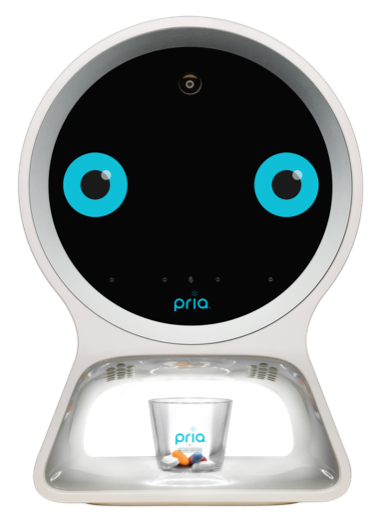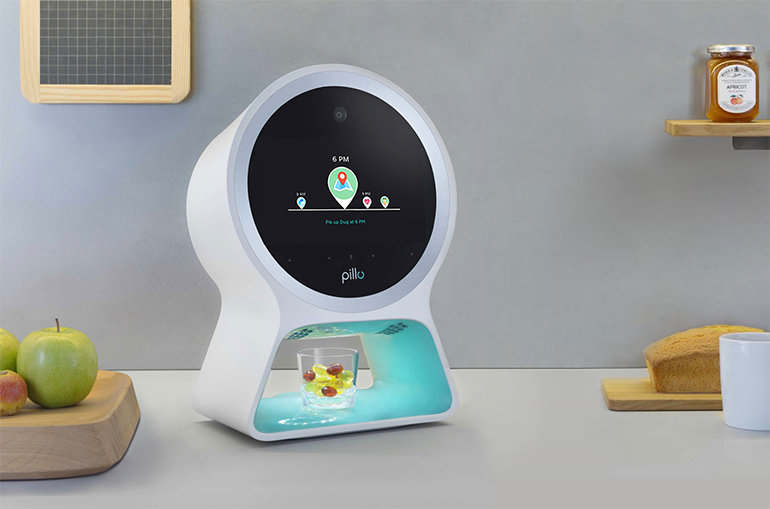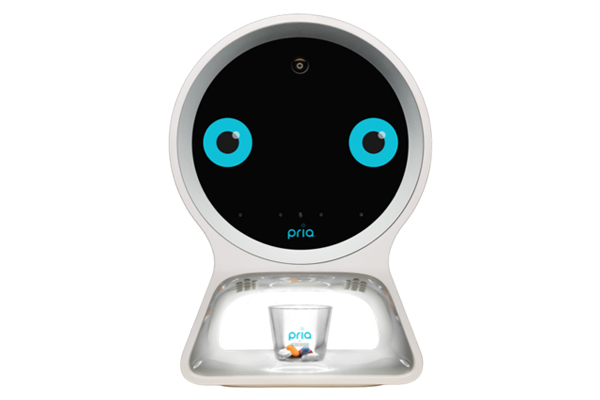Black & Decker Joins the Smart Healthcare Scene with Pria, a Home Care Companion

Pria; Photo Credit: Stanley Black & Decker
Stanley Black & Decker announced the development of a voice-enabled Home Care Companion, called Pria, at CES 2019. Stanley B&D worked in collaboration with Pillo Health to develop the Pria, after a strategic investment by Stanley Ventures in Pillo Health. Pillo Health is the company that introduced the Pillo pill dispenser early last year, which is what Pria seems to be based on both in terms of its aesthetic design and functionality. Stanley B&D has said that full commercialization of the product will be in about a month and that with the launch two websites (okpria.com and stanleyfutures.com) will be launched then too. No price for the device has been given.
Stanley Black & Decker also displayed Omni, a security and motion detection system that leverages a WiFi mesh network. In a Medgadget interview, a Stanley Black & Decker spokesperson said users would be able to connect the Omni system with the Pria, in order to detect where a Pria user is located in a house. The Omni network uses unique radio frequency (RF) sensing technology that can “see” and interpret WiFi signals. The development of a voice-enabled healthcare product by a company from a different field, like Stanley Black & Decker, confirms voice assistant’s importance in healthcare. The understanding that voice will revolutionize healthcare is so ubiquitous, that even companies from unrelated fields want to participate.
Pria Specs
Pria is a device that automates medication management, acting as a voice-controlled home health assistant. There is a companion app that must be used with Pria, allowing the device to schedule up to 28 medication doses, provide reminder alerts, dispense the correct medication at the correct time, track caregiver visits, and provide 24/7 customer service. Pria features an in-house digital assistant, allowing for two-way voice communication.
Specific queries users can ask Pria are not known yet. However, an example exchange given in a Medgadget interview by a Stanley B&D spokesperson was of a family member telling Pria to ask if a user had drunk two glasses of water that day. The user could respond with “Yes, I have had two glasses of water today,” in order to prompt Pria to notify the family member. The dispenser has a sensor to determine whether or not a user has taken dispensed medication, giving another example of how loved ones can keep track of a user.
Pria also includes a built-in camera, offering users the ability to engage in video check-ins with family or caregivers using voice interaction. Pria is very similar to the Pillo pill dispenser. However, it does differ with new features, such as human fall detection, and through an independent back end and mobile application.
Pria is Based on Pillo: The Automated Pill Dispenser and Personal Assistant

Pillo Automated Pill Dispenser; Photo Credit: Pillo Health
Founded in 2015, Pillo Health is the company behind a lot of Pria’s design and functionality. Pillo Health partnered with Orbita to provide a voice experience platform in their device, Pillo, which is also marketed as a digital healthcare companion. Pillo provides management of up to 28 doses of pills through a voice assistant, touchscreen, and mobile app. Facial recognition software is included to act as security, and the device also includes a camera. The camera allows caregivers, friends, and family to interact with users via video calls directly on the Pillo device.
A separate function that the Pria does not seem to offer, at least not yet, is the ability to act as a general-purpose voice assistant. Pillo’s partnership with Orbita allows for Pillo to handle a range of voice commands and queries, from asking about the weather, playing music, setting alarms or timers, to telling jokes and asking random questions. Pillo advertises itself as helping to answer health and wellness related queries, too. For example, users can utilize voice commands to ask about the nutritional value of their food: “How many calories are in an apple?” In response, Pillo will speak the answer and display results on the touch screen interface. The Pillo website even says users can ask Pillo to play NPR.
The companion mobile app allows users to stay connected with Pillo even when not nearby. Timers, alarms, notifications, and scheduling are all able to be set up on the app, the Pillo touchscreen interface, or by voice commands. With a user’s permission, caregivers, friends, and family can also use the app in order to be notified about any missed doses and monitor a user’s medical use. The device is currently out of stock due to high demand, according to the website, and costs $499 in addition to a $39.99/month subscription.
Despite Some Differences, Most Consumers Won’t Be Able to Differentiate Between Pria and Pillo
Pria looks almost exactly like Pillo, down to the cartoonish eyes and even the logo font. Pria also functions in almost the exact same way as the Pillo, leaving it likely that the feature sets will converge with ongoing collaboration. Voice commands are convenient for a device like this, but if Pria truly wants to establish itself as a hub for the home, it would greatly benefit from features that general-purpose voice assistants provide, like playing music or podcasts, getting the weather, or hearing about both your medicine schedule and your activity schedule for the day.
That being said, Pria has a great use case with a large market it can tap into and could gain even more voice-based functionality before the official launch. Price and distribution channels can be used to differentiate it from Pillo and Stanley B&D has already added distinctive new features for Pria. For example, with the location detection features that integration with an Omni system can provide users, the Pria becomes not just a device for one room, but the entire house.
Google Mobile App and Android Q Face Match Capabilities Likely to Arrive in Google Assistant
Hearing Aids as a Home for Smart Assistants – The Hearables Market Expands









